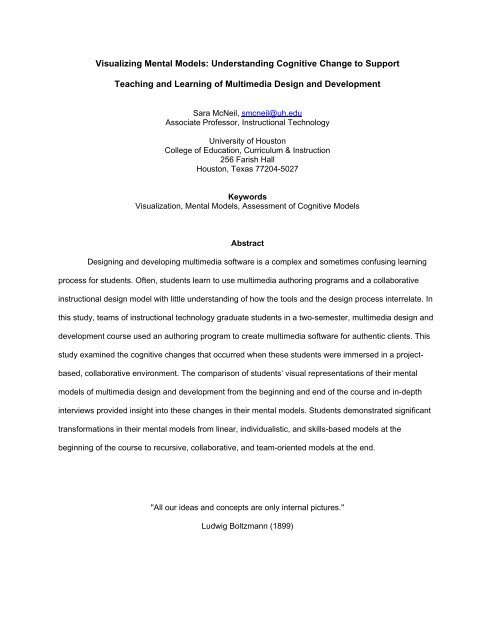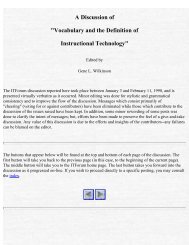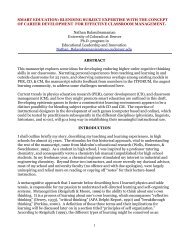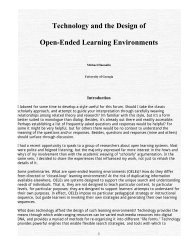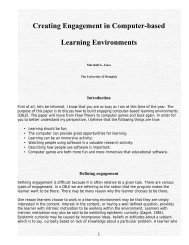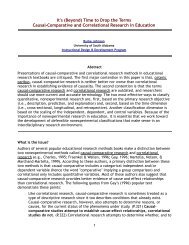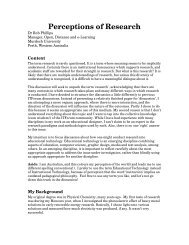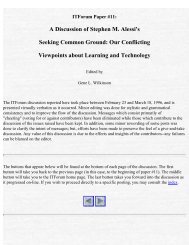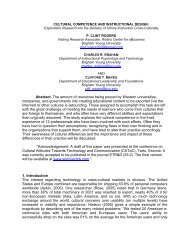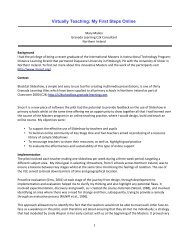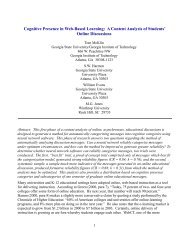Visualizing Mental Models: Understanding Cognitive Change to ...
Visualizing Mental Models: Understanding Cognitive Change to ...
Visualizing Mental Models: Understanding Cognitive Change to ...
Create successful ePaper yourself
Turn your PDF publications into a flip-book with our unique Google optimized e-Paper software.
<strong>Visualizing</strong> <strong>Mental</strong> <strong>Models</strong>: <strong>Understanding</strong> <strong>Cognitive</strong> <strong>Change</strong> <strong>to</strong> Support<br />
Teaching and Learning of Multimedia Design and Development<br />
Sara McNeil, smcneil@uh.edu<br />
Associate Professor, Instructional Technology<br />
University of Hous<strong>to</strong>n<br />
College of Education, Curriculum & Instruction<br />
256 Farish Hall<br />
Hous<strong>to</strong>n, Texas 77204-5027<br />
Keywords<br />
Visualization, <strong>Mental</strong> <strong>Models</strong>, Assessment of <strong>Cognitive</strong> <strong>Models</strong><br />
Abstract<br />
Designing and developing multimedia software is a complex and sometimes confusing learning<br />
process for students. Often, students learn <strong>to</strong> use multimedia authoring programs and a collaborative<br />
instructional design model with little understanding of how the <strong>to</strong>ols and the design process interrelate. In<br />
this study, teams of instructional technology graduate students in a two-semester, multimedia design and<br />
development course used an authoring program <strong>to</strong> create multimedia software for authentic clients. This<br />
study examined the cognitive changes that occurred when these students were immersed in a project-<br />
based, collaborative environment. The comparison of students’ visual representations of their mental<br />
models of multimedia design and development from the beginning and end of the course and in-depth<br />
interviews provided insight in<strong>to</strong> these changes in their mental models. Students demonstrated significant<br />
transformations in their mental models from linear, individualistic, and skills-based models at the<br />
beginning of the course <strong>to</strong> recursive, collaborative, and team-oriented models at the end.<br />
"All our ideas and concepts are only internal pictures."<br />
Ludwig Boltzmann (1899)
<strong>Visualizing</strong> <strong>Mental</strong> <strong>Models</strong>: <strong>Understanding</strong> <strong>Cognitive</strong> <strong>Change</strong> <strong>to</strong> Support<br />
Teaching and Learning of Multimedia Design and Development<br />
This paper reports on the analysis of visual representations of students’ mental models in order <strong>to</strong><br />
understand the cognitive changes that occurred during a collaborative and authentic multimedia design<br />
and development experience. Students were engaged in a two-semester graduate course that immersed<br />
them in a project-based learning environment designing software for authentic clients. The main objective<br />
of the course was <strong>to</strong> enable students <strong>to</strong> learn the collaborative design process in combination with<br />
authoring software and apply this knowledge in a real environment. The course focused on a practitioner<br />
model of instructional design (Seels & Glasgow, 1997), the application and use of specific authoring<br />
software (Authorware), and the development of workplace and teamwork skills.<br />
The workplaces of both <strong>to</strong>day and <strong>to</strong>morrow are demanding and dynamic, and require skills that<br />
are not merely exemplified as technological—logical, analytical, and technical, but also those represented<br />
as value skills—creativity, critical thinking, the ability <strong>to</strong> see the big picture, and working in a team (Datz,<br />
2004). Teaching multimedia design and development in isolated courses may decontextualize the<br />
learning experience for students. Situating the learning experience in a project-based approach allows<br />
students <strong>to</strong> develop strong technical skills and, at the same time, build value skills needed for careers in<br />
Educational Technology related jobs.<br />
Assessing students’ achievement of course objectives is critical, especially in this type of situated,<br />
collaborative environment. Instruc<strong>to</strong>rs can measure students’ achievement of some course objectives<br />
through assessing the product developed. Often a rubric with categories such as content, audience<br />
consideration, and design qualities is used <strong>to</strong> evaluate multimedia products (Green & Brown, 2002; San<br />
Mateo County Office of Education, 2000). Other course objectives can be measured through discussion<br />
either online or face-<strong>to</strong>-face, through observation of behavior, and through the use of tests or quizzes of<br />
factual knowledge. However, the changes in ideas and perceptions about the team development process<br />
are more difficult <strong>to</strong> observe and measure. This study focused on understanding the cognitive changes<br />
that occurred as part of the experience through students’ reflective process of creating visual<br />
representations of mental models of multimedia design and development at the beginning and end of the
<strong>Visualizing</strong> <strong>Mental</strong> <strong>Models</strong>: <strong>Understanding</strong> <strong>Cognitive</strong> <strong>Change</strong> <strong>to</strong> Support Teaching and Learning of Multimedia Design and Development<br />
course. Along with in-depth interviews about their learning experiences, these visual representations<br />
provided a means of understanding the complex changes that occurred during this experience.<br />
This study was guided by two questions:<br />
Objectives of the Study<br />
1. What mental models do beginning designers and developers of multimedia software possess?<br />
2. How are these mental models changed after an exposure <strong>to</strong> a project-based, authentic learning<br />
environment in which the authoring software was used as a cognitive <strong>to</strong>ol?<br />
My goal was <strong>to</strong> seek patterns in students’ visualizations of their mental models of multimedia<br />
design and development <strong>to</strong> determine whether the course objectives related <strong>to</strong> understanding<br />
collaboration in a team environment were met. In this study the mental models were used <strong>to</strong> judge the<br />
effectiveness of the invention, in other words, the effectiveness of the course in achieving the objectives.<br />
In addition, I wanted <strong>to</strong> understand not only the patterns but also the structure and organization of the<br />
mental model representations.<br />
Conceptual Framework<br />
Scottish psychologist, Kenneth Craik, is credited with first coining the term “mental model” in 1943. Craik’s<br />
definition of mental model was that of a thought process that provides a representation of some entity or<br />
system. Craik based his reasoning on the ability of humans <strong>to</strong> explore real and imaginary situations<br />
mentally, and he proposed the idea of thinking models that parallel reality:<br />
If the organism carries a small-scale model of external reality and its own possible<br />
actions within its head, it is able <strong>to</strong> try out various alternatives, conclude which is the best<br />
of them, react <strong>to</strong> future situations before they arise, utilize the knowledge of past events<br />
in dealing with the present and future, and in every way react <strong>to</strong> a much fuller, safer and<br />
more competent manner <strong>to</strong> emergencies which face it.<br />
2<br />
(Craik, 1943)
<strong>Visualizing</strong> <strong>Mental</strong> <strong>Models</strong>: <strong>Understanding</strong> <strong>Cognitive</strong> <strong>Change</strong> <strong>to</strong> Support Teaching and Learning of Multimedia Design and Development<br />
Similar <strong>to</strong> pictures in Wittgenstein’s (1922) "picture" theory of the meaning of language, mental models<br />
have a structure that is the equivalent of the structure they represent. <strong>Mental</strong> models are similar in<br />
structure <strong>to</strong> architects’ scale models of buildings, <strong>to</strong> biologists’ models of complex DNA, and <strong>to</strong> physicists’<br />
diagrams of particle interactions. A person must have a working model of the phenomenon in his or her<br />
mind in order <strong>to</strong> understand a real-world phenomenon. Take, for example, individual mental models of<br />
how cars operate. Although each person’s model would be different, each would be based on a similar<br />
structure and contain elements that mimic reality – gasoline, pis<strong>to</strong>ns, combustion, and exhaust. There are<br />
differences in novice and expert models, but each model reflects the individual’s understanding at that<br />
point in time. Although mental models are simpler and less complicated than real-world phenomena, they<br />
are similar in structure. This similarity allows the holder of the model <strong>to</strong> make mental inferences about the<br />
phenomenon that is also true in the real world.<br />
A learner’s mental model is highly individualized and constantly changing as more input and<br />
learning take place. Lambert and Walker (1995, p.1) stated that a mental model is, “an individual's<br />
existing understanding and interpretation of a given concept, which is formed and reformed on the basis<br />
of experiences, beliefs, values, socio-cultural his<strong>to</strong>ries, and prior perceptions. Our mental models (or<br />
schemas) affect how we interpret new concepts and events.” Nersessian (2007) proposed that mental<br />
models are “organized units of mental representation of knowledge employed in various cognitive tasks<br />
including reasoning, problem solving, and discourse comprehension.” (p. 9)<br />
Donald Norman (1988) gave a current definition of mental models: "…the models people have of<br />
themselves, others, the environment, or things with which they interact. People form mental models<br />
through experience, training and instruction." Norman also noted, “To gain control over a technical system<br />
humans try <strong>to</strong> build internal mental models of the things with which they are interacting. These models<br />
provide predictive and explana<strong>to</strong>ry power for understanding.” <strong>Cognitive</strong> science researchers and<br />
scientists propose that the mind constructs mental models as a result of perception, imagination and<br />
knowledge, and the understanding of discourse.<br />
<strong>Mental</strong> models have become known as a summation of all of a person's thoughts and<br />
understandings on a subject. More than just isolated bits of information, a mental model can become a<br />
system with which explora<strong>to</strong>ry inputs can be fed and observed for its resultant behavior (Carroll & Olson,<br />
3
<strong>Visualizing</strong> <strong>Mental</strong> <strong>Models</strong>: <strong>Understanding</strong> <strong>Cognitive</strong> <strong>Change</strong> <strong>to</strong> Support Teaching and Learning of Multimedia Design and Development<br />
1988.) <strong>Mental</strong> models are incomplete, unstable, easily confused, and based on superstition instead of<br />
scientific fact. Despite these limitations, mental models play a very important role in understanding human<br />
cognitive change.<br />
Learners construct new knowledge and modify existing knowledge as they experience situations,<br />
problems, circumstances, and other events in learning settings (Tzeng & Schwen, 2003). One way <strong>to</strong><br />
measure this learning is <strong>to</strong> examine the mental models of learners since they can reflect the type and<br />
level of construction that has occurred. Although mental models are different for novices and experts, the<br />
models of both continue <strong>to</strong> change as more knowledge is gained. Authentic project-based learning<br />
environments have the potential <strong>to</strong> provide an environment that allows students <strong>to</strong> experience learning in<br />
situated contexts, and these experiences enrich and change their mental models.<br />
In project-based learning, instruction and learning occur within the context of a challenging project<br />
(Thomas, 2000). Using a project with real-world clients analogous <strong>to</strong> complicated tasks encountered in<br />
<strong>to</strong>day’s workplaces, can act as a focus and catalyst for learning. Normally, projects extend over time <strong>to</strong><br />
act as interactive channels <strong>to</strong> help students acquire, new necessary knowledge, and skills. This approach<br />
is learner centered and encompasses multiple learning communities—peers, clients, users, instruc<strong>to</strong>rs,<br />
and experts.<br />
<strong>Mental</strong> <strong>Models</strong> and Other Visual Techniques of Knowledge Representation<br />
In a paper discussed on ITFORUM this fall, Mauri Ahlberg (2008) discussed different methods of<br />
graphically representing knowledge structures. Two methods of creating these representations that she<br />
discussed are significant <strong>to</strong> the current study: mind mapping and concept mapping.<br />
Mind Mapping<br />
Ahlberg (2008) noted that mind mapping was developed by Buzan (1974), a British psychologist,<br />
in the early 1970s, and he subsequently registered the term, Mind Map ®. Mind maps closely resemble<br />
4
<strong>Visualizing</strong> <strong>Mental</strong> <strong>Models</strong>: <strong>Understanding</strong> <strong>Cognitive</strong> <strong>Change</strong> <strong>to</strong> Support Teaching and Learning of Multimedia Design and Development<br />
an aerial view of a tree and are used <strong>to</strong> represent words, ideas, tasks, or other items. Sub-ideas are<br />
arranged in a branch-like, organic manner around the central key word or graphic that represents the<br />
main idea, problem or issue. In addition <strong>to</strong> the use of color as an organizing <strong>to</strong>ol, small icons and<br />
drawings are often used <strong>to</strong> enhance the words and meaning in a mind map. Brinkmann (2003) noted that<br />
a mind map allows crea<strong>to</strong>rs <strong>to</strong> use both sides of their brain which work <strong>to</strong>gether and “connects<br />
imagination with structure and pictures with logic.”<br />
Buzan’s company has developed software that facilitates the creation of mind maps called<br />
iMindMap (http://www.imindmap.com/). On the iMindMap website, there is a video under the education<br />
link about using mind maps for pre- and post-course assessment. The video states:<br />
…it (mind mapping) encourages students <strong>to</strong> think metaphorically. This type of thinking<br />
has been proven <strong>to</strong> be a useful means of interpreting and expressing complex ideas and<br />
concepts… Mind mapping provides visual and kinesthetic learners with a better chance<br />
of expressing their knowledge than traditional assessment techniques…Mind maps<br />
provide a more realistic representation of knowledge. The method that a mind map uses<br />
<strong>to</strong> bring <strong>to</strong>gether students’ knowledge moves away from the traditional linear ‘yes-no’<br />
assessment and allows their understanding <strong>to</strong> be more transparent. This provides a more<br />
realistic representation of their knowledge.<br />
(transcribed from Pre and Post Assessment in the Classroom video,<br />
iMindMap website)<br />
Neither the video nor the iMindMap website provides any citations or evidence <strong>to</strong> support these<br />
claims. Ahlberg (2008) noted that there is little empirical research on the efficacy of the mind mapping<br />
technique and cited a study by Farrand, Hussain, and Hennessey (2002) that suggested that using a<br />
mind mapping technique could improve recall of factual information by up <strong>to</strong> 10% over conventional study<br />
methods. On the iMindMap website, there are 12 articles dealing with the techniques and value of using<br />
mind maps, but all are clearly promotional material; none are research studies.<br />
See other examples of mind maps here:<br />
http://www.12manage.com/methods_mind_mapping.html.<br />
Concept Mapping<br />
Concept maps were developed in 1970s by Joseph Novak at Cornell University in his research in<br />
understanding changes in children’s knowledge of science (Novak & Musonda, 1991). Concept mapping<br />
5
<strong>Visualizing</strong> <strong>Mental</strong> <strong>Models</strong>: <strong>Understanding</strong> <strong>Cognitive</strong> <strong>Change</strong> <strong>to</strong> Support Teaching and Learning of Multimedia Design and Development<br />
is defined as “a technique of graphically representing concepts and their hierarchical interrelations along<br />
two dimensions” (Beyerbach, 1988). Concept maps are used <strong>to</strong> graphically represent knowledge and<br />
feelings and are composed of concepts that are labeled in circles or boxes. The relationships between<br />
two concepts are shown by a connecting line that links both concepts. Words are written on this line that<br />
specifies the relationship between the two concepts. The unit composed of two concepts and the linking<br />
word is called a proposition. Although the relationships are usually hierarchical, multiple linkages are<br />
possible (Jonassen, Beissner, & Yacci, 1993).<br />
Concept mapping is one technique for assessing students’ mental models of complex concepts.<br />
Concept maps are useful <strong>to</strong>ols in instruction and reflection as well as evaluation of students’ learning.<br />
Studies involving concept maps have been conducted with a variety of students as young as third grade<br />
through higher education. In addition <strong>to</strong> measuring changes in cognitive knowledge, concept maps have<br />
been used <strong>to</strong> show attitudinal changes as well. A concept map is a useful <strong>to</strong>ol for obtaining information on<br />
how the learner organizes information, what key concepts are included, and what types of relationships<br />
exist between the concepts.<br />
Novak and Cañas (2008) noted that concept maps may also be used for the assessment of<br />
student understanding. In the latest versions of CmapTools, a concept mapping software, there is an<br />
option <strong>to</strong> compare an “expert” concept map for a <strong>to</strong>pic with maps constructed by students, and all similar<br />
or different concepts and propositions are shown in color. However, Novak and Cañas state that there is<br />
no data available about this use.<br />
Drawbacks Using Mind Mapping and Concept Mapping<br />
Brinkmann (2003) described a set of rules for using mind maps that she derived from a list of<br />
sources including Buzan. These rules are very specific and include, “Use a large sheet of paper without<br />
lines in a landscape format” and “The <strong>to</strong>pic of the mind map should be displayed in an eye-catching way,<br />
preferably by a coloured image.” (p. 36) There are also rules for creating concept maps. Novak and<br />
Cañas (2008) stated:<br />
Given a selected domain and a defined question or problem in this domain, the next step<br />
is <strong>to</strong> identify the key concepts that apply <strong>to</strong> this domain. Usually 15 <strong>to</strong> 25 concepts will<br />
6
<strong>Visualizing</strong> <strong>Mental</strong> <strong>Models</strong>: <strong>Understanding</strong> <strong>Cognitive</strong> <strong>Change</strong> <strong>to</strong> Support Teaching and Learning of Multimedia Design and Development<br />
suffice. These concepts could be listed, and then from this list a rank ordered list should<br />
be established from the most general, most inclusive concept, for this particular problem<br />
or situation at the <strong>to</strong>p of the list, <strong>to</strong> the most specific, least general concept at the bot<strong>to</strong>m<br />
of the list. Although this rank order may be only approximate, it helps <strong>to</strong> begin the<br />
process of map construction. We refer <strong>to</strong> the list of concepts as a parking lot, since we<br />
will move these concepts in<strong>to</strong> the concept map as we determine where they fit in. Some<br />
concepts may remain in the parking lot as the map is completed if the mapmaker sees no<br />
good connection for these with other concepts in the map.<br />
Both mind maps and concept maps provide structures for creating visual representations of<br />
knowledge, but because of their predetermined structure and rules, I felt that they may hinder the natural<br />
expression of a mental model. In this study, students were not given a defined structure <strong>to</strong> use for their<br />
mental model representations so that the representations could be as genuine and spontaneous as<br />
possible. No directions were given about how the representations should be drawn except for the paper<br />
and <strong>to</strong>ols <strong>to</strong> be used. Some students had previous knowledge about concept maps, but few of the<br />
representations they created had qualities of either mind maps or concept maps.<br />
The Project-Based Learning Experience<br />
This study was situated in a two-semester, graduate course focused on advanced instructional<br />
design principles, the application and use of a specific authoring program (Authorware) <strong>to</strong> create<br />
software for an actual client, and the development of workplace and team skills needed for optimal<br />
interaction and collaboration.<br />
On the first night of class, students completed an initial assessment of computer skills, multimedia<br />
skills, and team strategies. Students were presented with brief descriptions of the proposed projects and<br />
asked <strong>to</strong> rank their first, second, and third choices. The second week of class, students were assigned <strong>to</strong><br />
four different teams based on a combination of fac<strong>to</strong>rs: the skills assessments, instruc<strong>to</strong>r’s knowledge of<br />
each student’s abilities and background, and student preference. Most students received their first or<br />
second choice. Clients included the Children’s Museum, the Museum of Fine Arts, Hous<strong>to</strong>n, and the<br />
Franz Meyer Museum of Mexico City.<br />
During the first part of the course (mid-August through mid-December), the teams identified<br />
instructional needs, formulated objectives, wrote content, and created s<strong>to</strong>ryboards for the project. In the<br />
7
<strong>Visualizing</strong> <strong>Mental</strong> <strong>Models</strong>: <strong>Understanding</strong> <strong>Cognitive</strong> <strong>Change</strong> <strong>to</strong> Support Teaching and Learning of Multimedia Design and Development<br />
second part of the course (mid-January through mid-May), the teams designed the interface and<br />
graphical elements, used Authorware <strong>to</strong> develop the project, and evaluated the software with target<br />
users. Throughout the design and development of the software, the teams worked closely with their<br />
clients in an iterative and recursive process which provided for a meaningful situated context for their<br />
learning experience.<br />
Over the nine month experience, the role of the instruc<strong>to</strong>r in this course changed from information<br />
provider <strong>to</strong> facilita<strong>to</strong>r <strong>to</strong> observer as teams assumed increasing responsibility for both their learning<br />
process and their product.<br />
Methods and Data Sources<br />
Using a multifaceted approach, data collection included eliciting pre- and post-course visual<br />
representations of students’ mental models of multimedia design and development as well as conducting<br />
in-depth interviews, and examining peer-evaluations of team performance, weekly individual and team<br />
reflections of progress, and evaluating the actual software that was developed. Participants in this study<br />
were graduate (masters and doc<strong>to</strong>ral level) instructional technology students who had completed<br />
introduc<strong>to</strong>ry courses in instructional design and courseware authoring.<br />
Data collection began in the first class meeting with collecting students’ initial mental models of<br />
multimedia design and development. Students were asked <strong>to</strong> create this visual representation on a single<br />
piece of paper using pencils, pens, or color markers. Technology applications such as Inspiration were<br />
not used because I felt that they would filter students’ representations through a pre-determined format,<br />
and they would require prior knowledge of the <strong>to</strong>ols. In addition, I did not ask students <strong>to</strong> use the structure<br />
of either mind mapping or concept mapping since I wanted students <strong>to</strong> express their initial<br />
representations as easily and as simply as possible. At the end of the course, students were once again<br />
asked <strong>to</strong> visually represent their mental models of multimedia design and development using the same<br />
parameters as the first. Students did not see or discuss their pre-course maps after creating them.<br />
Other techniques were also used <strong>to</strong> gather data. Interviews were conducted by another<br />
researcher and were taped and transcribed. The objective for the interviews was <strong>to</strong> gain access <strong>to</strong><br />
students’ understandings, feelings, and attitudes about their design and development process in the<br />
8
<strong>Visualizing</strong> <strong>Mental</strong> <strong>Models</strong>: <strong>Understanding</strong> <strong>Cognitive</strong> <strong>Change</strong> <strong>to</strong> Support Teaching and Learning of Multimedia Design and Development<br />
collaborative project-based environment. Two peer-evaluations were conducted for each team member at<br />
the middle (December) and end (May) of the courses. Peer evaluations used a Likert scale and open<br />
ended responses <strong>to</strong> questions about team performance, member roles, and achievement of course<br />
objectives. Finally, both individual and team reports that students posted as documentation of weekly<br />
progress were collected using an on-line form and database.<br />
All these forms of data from multiple sources collected using different methods were examined for<br />
significant themes that documented the changes in students’ mental models of multimedia design and<br />
development. The process included looking for themes and patterns in the data as well as examining the<br />
structure and organization of the visual representations of the mental models (Gentner & Stevens, 1983;<br />
Johnson-Laird, 1983).<br />
Organizing and Measuring <strong>Mental</strong> <strong>Models</strong><br />
Doyle, Radzicki, and Trees (2008) noted that there are a variety of formal techniques used by<br />
researchers <strong>to</strong> organize and represent mental model information. These include systems flow diagrams,<br />
causal loop diagrams, influence diagrams, hexagons, and social fabric matrices. The problem with using<br />
one of these techniques is that these techniques were designed <strong>to</strong> facilitate change in mental models not<br />
<strong>to</strong> measure change. Doyle et al. (2008) stated “…the very features that make them valuable for changing<br />
mental models …simultaneously make them unsuitable for measuring that change in an accurate and<br />
unbiased way.” These researchers proposed that any method for measuring mental models should have<br />
eight goals: (1) attain a high degree of experimental control; (2) separate measurement and<br />
improvement; (3) collect data from individuals in isolation; (4) collect detailed data from the memory of<br />
each individual; (5) measure change rather than perceived change; (6) obtain quantitative measures of<br />
characteristics of mental models; (7) employ a naturalistic task and response format; and (8) obtain<br />
sufficient statistical power. Studies by Vennix (1990) and Doyle et al. (2007) using these goals relied on<br />
detailed content analysis of written essays and did not use any form of visual representation. The present<br />
study applied this same approach but used the analysis and interpretation of visual models.<br />
9
<strong>Visualizing</strong> <strong>Mental</strong> <strong>Models</strong>: <strong>Understanding</strong> <strong>Cognitive</strong> <strong>Change</strong> <strong>to</strong> Support Teaching and Learning of Multimedia Design and Development<br />
Semiotic Analysis<br />
Measuring learners’ cognitive change is a complex task, and many types of data may be used <strong>to</strong><br />
assess and analyze mental models. In this study, changes in the mental models of learners were studied<br />
using semiotic analysis of the pre- and post-course visual representations. Semiotics is a philosophical<br />
approach that seeks <strong>to</strong> interpret messages in terms of their signs and patterns of symbolism. As a field of<br />
study, semiotics offers a framework for understanding visual representations of concepts and provides a<br />
way <strong>to</strong> understand and compare different representations. As a mode of analysis, semiotics attempts <strong>to</strong><br />
uncover the rules and principles that account for patterns of behavior as well as <strong>to</strong> interpret<br />
communication patterns through the use of metaphors. “A metaphor substitutes one expression for<br />
another in order <strong>to</strong> produce an expansion (or a ‘condensation’) of knowledge at the semantic level.” (Eco,<br />
1990).<br />
Kress and van Leeuwen (1996) proposed a vocabulary for visual semiotics that provides a<br />
descriptive framework for analysis: (1) representational meaning, how the image and its parts represent<br />
the world; (2) interactive meaning, the interaction that the image contains or represents; and (3)<br />
compositional meaning, how the layout, placement and salience of the image combine <strong>to</strong> provide the <strong>to</strong>tal<br />
composition. Representational meaning is further classified in<strong>to</strong> one of two visual syntactic patterns:<br />
narrative structures that contain vec<strong>to</strong>rs that either directly or subconsciously connect parts and direct the<br />
gaze of the viewer, and conceptual structures that visually define, analyze or classify parts (Jewitt &<br />
Oyama, 2001). Interactive meaning is divided in<strong>to</strong> three parts: (a) contact, making contact with the viewer<br />
<strong>to</strong> establish a relationship; (b) distance, the framing of an image <strong>to</strong> be close or far; and (c) point of view,<br />
the perspective from which the image is taken. Compositional meaning is divided in<strong>to</strong> four parts: (a)<br />
information value, where the elements are placed in a composition; (b) framing, how the elements in a<br />
composition are ‘connected’ or ‘disconnected’ from one another; (c) salience, making some elements<br />
stand out more than others; and (d) modality, the form of the visual itself. For this study, only<br />
representational meaning and compositional meaning were used <strong>to</strong> structure the analysis since the<br />
visuals were drawings, and interactive meaning was difficult <strong>to</strong> determine.<br />
10
<strong>Visualizing</strong> <strong>Mental</strong> <strong>Models</strong>: <strong>Understanding</strong> <strong>Cognitive</strong> <strong>Change</strong> <strong>to</strong> Support Teaching and Learning of Multimedia Design and Development<br />
<strong>Change</strong>s in <strong>Mental</strong> <strong>Models</strong><br />
Participants in this study demonstrated significant changes in their mental models over the two-<br />
semester period. Three major themes emerged from the comparison of pre- and post-course<br />
representations of their mental models. The themes indicated change from a linear, individualistic, and<br />
skills-based model <strong>to</strong> a recursive, collaborative, and team-oriented model.<br />
The themes were:<br />
1. Structure and Organization of the mental models changed from isolated and individualistic<br />
representations <strong>to</strong> collaborative and team oriented processes.<br />
2. The Mindset and Attitudes of the students changed from skills in isolation <strong>to</strong> teamwork and<br />
collaboration.<br />
3. Knowledge Constructs in the representations changed from a focus on small, isolated units or<br />
the individual parts <strong>to</strong> the whole, a cognitive model that included the big picture.<br />
In order <strong>to</strong> develop these themes, I looked for patterns in the students’ representations,<br />
interviews, and journals that indicated change and organized the emerging patterns in tables. Analysis<br />
was aided by discussion with other researchers of the emerging patterns and furthered by repeatedly<br />
reading and seeking for confirming and disconfirming membership of these patterns under possible<br />
categories. This process resulted in the development of the final themes summarized in Table 1. The<br />
differences noted here may be indicative of students’ changes in their mental models of multimedia<br />
design and development.<br />
It is important <strong>to</strong> note that the post representations of mental models are distinct from the pre-<br />
course representations, perhaps as expected. What makes these findings interesting is the display of<br />
specific emphasis on collaborative teamwork and the importance of both technical and value skills in the<br />
final representations. I believe that this is not merely a happy coincidence, but a result of the carefully<br />
designed and implemented two-semester long course experience that was perceived as authentic and as<br />
11
<strong>Visualizing</strong> <strong>Mental</strong> <strong>Models</strong>: <strong>Understanding</strong> <strong>Cognitive</strong> <strong>Change</strong> <strong>to</strong> Support Teaching and Learning of Multimedia Design and Development<br />
close <strong>to</strong> a real-world experience as possible in an academic setting. The project-based learning<br />
experience itself, not merely technical skills or theoretical learning (e.g., instructional design theory)<br />
influenced the students’ construction of a mental model that reflected the inherent complexity of the<br />
process of multimedia design and development.<br />
Table 1. <strong>Change</strong>s in Students’ <strong>Mental</strong> <strong>Models</strong> Grouped by Theme<br />
PRE POST<br />
Theme 1. Structure and Organization<br />
Each step of the multimedia design and<br />
development process is carefully contained in its<br />
own space.<br />
Process is represented as linear and directional<br />
(indicated by one way arrows).<br />
12<br />
Phases of the multimedia design and<br />
development process are overlapping,<br />
intermingled, and recursive.<br />
Process is largely represented as overlapping,<br />
circular, and spiral (represented by multidirectional,<br />
often circular movement).<br />
Process has fewer steps. Process has multiple interactive processes.<br />
Job titles such as designer, developer, client, user,<br />
are largely isolated from each other.<br />
Job titles are not a strong focus; instead the<br />
focus is on the output of that phase.<br />
Process is ordered, separated, and regimented. Less structured, more dynamic and interrelated.<br />
Theme 2. Mindset, Attitudes<br />
Individualistic mindset is primary in the<br />
representations. (What do I need <strong>to</strong> know? What can<br />
I do?)<br />
Collaborative mindset is central in the<br />
representation. (What does the team do?)<br />
If used, the team is only a part of the whole process. The team is an all-encompassing part of the<br />
entire process.<br />
Little appreciation of the value of the team is<br />
demonstrated.<br />
The focus on the team is well demonstrated.<br />
Few value skills are represented. Many value skills (e.g., creativity, critical<br />
Emphasis on hands-on abilities such as using a<br />
specific application is noted in the representations.<br />
thinking, and communication) are represented.<br />
Emphasis on cognitive skills such as<br />
theoretical planning and knowledge of process<br />
is noted in the representations.<br />
Theme 3. Knowledge Constructs<br />
Less content is shown in the representation. Dense content is shown in the representation.
<strong>Visualizing</strong> <strong>Mental</strong> <strong>Models</strong>: <strong>Understanding</strong> <strong>Cognitive</strong> <strong>Change</strong> <strong>to</strong> Support Teaching and Learning of Multimedia Design and Development<br />
Focus of the content is on technical skills. Focus of the content is on multiple skills<br />
(including both technical and value skills) and<br />
how they relate.<br />
If used, teamwork is isolated and is a small part. Teamwork is usually at the center and is a<br />
large part.<br />
Concepts described in the content are simple and<br />
lacking continuity.<br />
13<br />
Concepts described in the content are complex<br />
and cohesive.<br />
Instructional design ideas depicted are largely that of Instructional design ideas depicted are more<br />
a simple systematic model.<br />
complex and originate from a need, rather than<br />
a stepwise model.<br />
In addition <strong>to</strong> using semiotic framework <strong>to</strong> analyze the mental models, I also used the following<br />
four key objectives of the course as lenses through which <strong>to</strong> further analyze the representations: (1)<br />
Multimedia, (2) Authoring Software, (3) Design and Development in Collaborative Teams, and (4)<br />
Instructional Design. These key aspects are intrinsic <strong>to</strong> the multimedia design and development process<br />
and were used by the instruc<strong>to</strong>r <strong>to</strong> build the course outcomes and structure the learners’ experiences. I<br />
applied this approach <strong>to</strong> understand the changes in students’ mental models of multimedia design and<br />
development for each student by analyzing that student’s data as a separate case. These analyses<br />
demonstrated that what may have seemed like isolated and discrete notions about multimedia design and<br />
development gathered from prior experiences clearly evolved <strong>to</strong> show richer and more complex<br />
understandings of the process.<br />
Two students’ visualizations of their mental models prior <strong>to</strong> and at the end of the two-semester<br />
experience are shared here <strong>to</strong> illustrate the changes in mental models. While participants’ pre-course<br />
mental models differed, they were all clearly influenced by their prior experiences and knowledge of<br />
computer and multimedia skills, and team strategies. In the post-course representations, the participants’<br />
mental models all showed an increase in the importance of collaboration, teamwork, and value skills.<br />
Student 1
<strong>Visualizing</strong> <strong>Mental</strong> <strong>Models</strong>: <strong>Understanding</strong> <strong>Cognitive</strong> <strong>Change</strong> <strong>to</strong> Support Teaching and Learning of Multimedia Design and Development<br />
Student 1 Pre-Course Representation Student 1 Post-Course Representation<br />
Figure 1. Student 1 - PRE<br />
The visual representation of Student 1’s pre-course mental model is presented in Figure 1.<br />
Student 1 - PRE contains 17 items and has four streams coming off of one main concept at the center of<br />
the representation: technical skills. The four streams are: applications, choice of application, learning<br />
curve, and implementation. Applications is divided in<strong>to</strong> four sub<strong>to</strong>pics: graphics, video, voice, and<br />
Authorware. Choice of application is divided in<strong>to</strong> three sub<strong>to</strong>pics: Why?, Where?, and When? Learning<br />
14
<strong>Visualizing</strong> <strong>Mental</strong> <strong>Models</strong>: <strong>Understanding</strong> <strong>Cognitive</strong> <strong>Change</strong> <strong>to</strong> Support Teaching and Learning of Multimedia Design and Development<br />
curve is divided in<strong>to</strong> three sub<strong>to</strong>pics: book resources, tu<strong>to</strong>ring, and time. The fourth stream,<br />
implementation, is divided in<strong>to</strong> two sub<strong>to</strong>pics: objective of the project and team work.<br />
Semiotic Analysis<br />
Representational meaning: The representation of Student 1’s PRE mental model is similar <strong>to</strong> a<br />
concept map and contains solid lines that are used <strong>to</strong> connect the streams <strong>to</strong> the main <strong>to</strong>pic and dotted<br />
lines that are used <strong>to</strong> indicate connections between sub<strong>to</strong>pics. It is substantially different from a concept<br />
map in that it does not contain words that specify the relationship between the two concepts.<br />
Compositional meaning. The placement of elements in the PRE model emphasizes technical<br />
skills since the oval that contains those words is larger and centered. The elements are all connected with<br />
a line, but each element ‘stands alone’ in a separate oval that doesn’t directly <strong>to</strong>uch another. Four dotted<br />
lines connect learning curve and implementation, learning curve and applications, choice of application<br />
and implementation, and choice of application and applications. Color is used <strong>to</strong> further classify elements<br />
in<strong>to</strong> groups, but it doesn’t appear <strong>to</strong> serve any other purpose. The shapes are all organic, but similar. Size<br />
of the ovals and placement indicate importance of each element. There is an open space at the lower<br />
right side of the model that makes it seem incomplete and lop-sided as if another stream was <strong>to</strong> be<br />
placed there.<br />
Course Objectives Analysis<br />
Multimedia. Student 1 - PRE presents a techno-centric view of multimedia. With technical skills at<br />
the center of the representation, there seems <strong>to</strong> be an emphasis on hands-on abilities rather than<br />
cognitive skills such as knowledge of the whole process or an instructional design model. The student<br />
does show four aspects of multimedia: the authoring software, video, voice and graphics.<br />
Authoring Software. Student 1 – PRE has a stream that lists applications for authoring software<br />
and includes several different types of media. Instead of listing generic applications for the authoring<br />
program, Student 1 – PRE lists the specific software used for the projects.<br />
15
<strong>Visualizing</strong> <strong>Mental</strong> <strong>Models</strong>: <strong>Understanding</strong> <strong>Cognitive</strong> <strong>Change</strong> <strong>to</strong> Support Teaching and Learning of Multimedia Design and Development<br />
Design and Development in Collaborative Teams. Student 1 – PRE lists one item related <strong>to</strong><br />
design teams: team work. No characteristic or skill associated with working in a team is shown.<br />
Instructional Design. Student 1 – PRE provides one item related <strong>to</strong> instructional design: objective<br />
of project. Although all students had a knowledge of a generic instructional design model through<br />
previous coursework, individual steps of an ID model were rarely used in the PRE representations.<br />
Figure 2. Student 1 – POST<br />
Student 1- POST contains 38 items and has interlocking circles around one main concept at the<br />
center: Goal: Multimedia Product. There are not clear streams; instead the circles, with the word skill at<br />
each juncture of the circles, seem <strong>to</strong> be connected and interrelated. In comparison <strong>to</strong> the student’s first<br />
16
<strong>Visualizing</strong> <strong>Mental</strong> <strong>Models</strong>: <strong>Understanding</strong> <strong>Cognitive</strong> <strong>Change</strong> <strong>to</strong> Support Teaching and Learning of Multimedia Design and Development<br />
visual representation, it shows a much richer view of multimedia and the surrounding fac<strong>to</strong>rs. In addition,<br />
the interrelatedness of the items begins <strong>to</strong> show the complexity of the cognitive model and the<br />
relationships of the items. Many skills, rather than merely technical skills, are a part of the complex<br />
process.<br />
Semiotic Analysis<br />
Representational meaning. This image does not contain vec<strong>to</strong>rs; instead, the conceptual<br />
structures, circles, are joined and interconnected like a ring with no beginning and end. The meaning is<br />
clear that the crea<strong>to</strong>r meant for the elements <strong>to</strong> be seen as interrelated as well as having shared<br />
boundaries much like a Venn diagram.<br />
Compositional meaning. The elements are placed significantly in the composition with<br />
overlapping edges and mutual boundaries providing a connected, cohesive framing. It is significant that<br />
no element stands out more than others with the exception of the center label, Goal: Multimedia Product.<br />
Course Objectives Analysis<br />
Multimedia. Student 1 - POST presents a very different view of multimedia than Student 1 - PRE.<br />
Multimedia is integrated in<strong>to</strong> the center of the representation, and there is less focus on the software<br />
application (Authorware) and more emphasis on the collaborative product.<br />
Authoring Software. Student 1 – POST integrates authoring skills throughout the representation<br />
with such items as Audio, Interface Layout, Graphics, Animation, and Authorware.<br />
Design and Development in Collaborative Teams. Student 1 – POST contains several items<br />
related <strong>to</strong> team qualities in addition <strong>to</strong> the one item, Team, that was used in the PRE representation.<br />
Items related <strong>to</strong> design teams include: Cooperation, Shared Responsibility, Written Communication, and<br />
Oral Communication, all important aspects of value skills.<br />
17
<strong>Visualizing</strong> <strong>Mental</strong> <strong>Models</strong>: <strong>Understanding</strong> <strong>Cognitive</strong> <strong>Change</strong> <strong>to</strong> Support Teaching and Learning of Multimedia Design and Development<br />
Instructional Design. Student 1 – POST provides one item: instructional design. At first glance,<br />
this omission seemed negative. However, this could be indicative that the student had internalized core<br />
tenets of instructional design in<strong>to</strong> the entire process. One of the objectives of the course was that the final<br />
product demonstrates the participants’ knowledge of a collaborative instructional design model. The<br />
absence of specific steps in the instructional design process in the final mental model representation<br />
supports that this internalization may have occurred. Other evidence I used <strong>to</strong> make this assertion was a<br />
careful evaluation of the final multimedia product, by the students, instruc<strong>to</strong>rs and clients, as well as a<br />
group of target users. Additional contributing indica<strong>to</strong>rs of this internalization included observations of the<br />
team’s application of the instructional design process as well as individual and team journals.<br />
The interview data also supports the changes demonstrated in the visual representations<br />
of Student 1’s mental models. She described how her attitude has changed from an isolated<br />
teacher designing materials alone <strong>to</strong> working with other teachers in a collaborative environment.<br />
… as a teacher – a secondary teacher – we are often alone, isolated. And we’re<br />
<strong>to</strong>tally responsible for our students, our content, what we teach. And we don’t have that<br />
opportunity unless we make the effort, after school, weekends, evenings, <strong>to</strong> meet with<br />
someone else and share and do something <strong>to</strong>gether. During the day there’s no time.<br />
And so I always think I’m going <strong>to</strong> work <strong>to</strong>gether with other people, do projects<br />
<strong>to</strong>gether. And I started doing a lot of that in the last two years that I taught, but it wasn’t<br />
really with other teachers it was people outside like at the public library, or – I did a lot of<br />
work with different libraries. And so I never got <strong>to</strong> do that sharing or working <strong>to</strong>gether as<br />
a team. I always ended up being responsible for doing things by myself.<br />
And so what I really thought was great about this is that we were all teachers,<br />
and we got <strong>to</strong> work <strong>to</strong>gether. And so for me I realized, hey, you know, what? Teachers<br />
can work <strong>to</strong>gether. So it was a great experience even though we’re – none of us are<br />
really teaching. I mean, I guess I’m the closest <strong>to</strong> the teaching. But it was a great<br />
experience, you know, for working <strong>to</strong>gether. And I think – I realize that, you know, I can<br />
work in a team. I can work <strong>to</strong>gether and get a project completed. You know, so it was<br />
reaffirming in that way.<br />
18
<strong>Visualizing</strong> <strong>Mental</strong> <strong>Models</strong>: <strong>Understanding</strong> <strong>Cognitive</strong> <strong>Change</strong> <strong>to</strong> Support Teaching and Learning of Multimedia Design and Development<br />
Student 2<br />
Student 2 Pre-Course Representation Student 2 Post-Course Representation<br />
The visual representation of Student 2’s pre-course mental model is presented in Figure 3.<br />
Student 2 - PRE emphasizes skills – the main <strong>to</strong>pic noted in the center circle. The representation contains<br />
32 items and has five streams coming off of one main concept at the center of the representation: skills<br />
for CUIN 7327 (the name of the course). It is interesting <strong>to</strong> note that this representation has words<br />
immediately above each sub<strong>to</strong>pic that create more meaning; these words are shown below in brackets.<br />
The five streams are: technical skills, instructional design skills, public relations skills, knowledge<br />
acquisition skills, and teamwork skills. Technical skills is divided in<strong>to</strong> six sub<strong>to</strong>pics: [learn] program,<br />
[create method of] navigation, [add] applications, [test &] troubleshoot, [adapt <strong>to</strong> different] levels, and<br />
[gain skills in] programming. Instructional design skills is divided in<strong>to</strong> five sub<strong>to</strong>pics: [add] graphics,<br />
[decide on] sequence, [make it] user-friendly, [appeal <strong>to</strong> audience], and [create] layout. Public relations<br />
skills with client is divided in<strong>to</strong> four sub<strong>to</strong>pics: [assess] needs, [produce] presentations, [good]<br />
communication, and [present] ideas. The fourth stream, knowledge acquisition skills is divided in<strong>to</strong> six<br />
sub<strong>to</strong>pics: [research] <strong>to</strong>pic, [gather] information [from client], [align] content [with objectives], [write]<br />
19
<strong>Visualizing</strong> <strong>Mental</strong> <strong>Models</strong>: <strong>Understanding</strong> <strong>Cognitive</strong> <strong>Change</strong> <strong>to</strong> Support Teaching and Learning of Multimedia Design and Development<br />
content, [edit] content, and [establish] assessment. Teamwork skills is divided in<strong>to</strong> six sub<strong>to</strong>pics: [set<br />
aside] time, [equal] participation, [be] flexible, trust, [open] communication, and [build upon] strength.<br />
Figure 3. Student 2 - PRE<br />
Semiotic Analysis<br />
20
<strong>Visualizing</strong> <strong>Mental</strong> <strong>Models</strong>: <strong>Understanding</strong> <strong>Cognitive</strong> <strong>Change</strong> <strong>to</strong> Support Teaching and Learning of Multimedia Design and Development<br />
Representational meaning. This image does not contain obvious vec<strong>to</strong>rs; instead, the conceptual<br />
elements, shapes like flower petals, are arranged around the center circle. The placement of the shapes<br />
is very structured, and no shape <strong>to</strong>uches another. Each sub<strong>to</strong>pic is carefully, but invisibly, joined <strong>to</strong> the<br />
corresponding <strong>to</strong>pic.<br />
Compositional meaning. The elements share no boundaries. Each of the streams is roughly equal<br />
size, and each of the sub<strong>to</strong>pics is approximately the shape and dimensions. No element stands out more<br />
than others with the exception of the center circle, skills for CUIN 7327. The composition is carefully<br />
balanced, unlike Student 1’s PRE lopsided representation, and each element is positioned precisely so<br />
nothing feels random or haphazard. The modality of the image is decorative and resembles a poster or<br />
graphic rather than a representation of a mental model.<br />
Course Objectives Analysis<br />
Multimedia. Student 2 - PRE also emphasizes skills but only one, [add] graphics under the<br />
stream, instructional design skills, recognizes the multimedia aspect of the course. There is no mention of<br />
any other feature of multimedia such as audio, video, animation, interactivity, or non-linear navigation.<br />
Authoring Software. Student 2 – PRE has stream for technical skills that contains [learn] program<br />
and [gain skills in] programming, but no mention is made of the particular software program used. The<br />
emphasis is on programming, not authoring.<br />
Design and Development in Collaborative Teams. Student 2 – PRE created a stream called<br />
teamwork skills, noting needs of the team <strong>to</strong> [set aside] time, have [equal] participation, <strong>to</strong> [be] flexible, <strong>to</strong><br />
trust, <strong>to</strong> have [open] communication, and <strong>to</strong> [build upon] strengths.<br />
Instructional Design. Student 1 – PRE provides several sub<strong>to</strong>pics related <strong>to</strong> instructional design,<br />
but interestingly enough they are scattered in other streams as well as the one labeled instructional<br />
design skills. For example, [establish] assessment is under knowledge acquisition skills, and [assess]<br />
needs in under public relations skills with client. The items listed under instructional design skills are a bit<br />
21
<strong>Visualizing</strong> <strong>Mental</strong> <strong>Models</strong>: <strong>Understanding</strong> <strong>Cognitive</strong> <strong>Change</strong> <strong>to</strong> Support Teaching and Learning of Multimedia Design and Development<br />
unusual as well. Three items, [add] graphics, [create] layout and [make it] user friendly are more graphic<br />
design skills rather than instructional design skills.<br />
Overall, Student 2’s PRE mental model representation is unusual because each item is carefully<br />
segmented and roughly equidistant from each other. The shapes are self-contained and stylized, and<br />
they are not connected with a mechanical means like a line. The interconnectedness of the items and<br />
their relationship <strong>to</strong> each other, except for falling under a particular stream, is not demonstrated. As far as<br />
size of the elements, each of the five main streams is the same size and the sub<strong>to</strong>pics are the same size;<br />
size is not used <strong>to</strong> emphasize any sub<strong>to</strong>pic.<br />
Student 2 - POST<br />
Student 2- POST contains 20 items and is composed of very organic, freeform shapes that seem<br />
<strong>to</strong> fit in<strong>to</strong> one another like puzzle pieces. Like Student 1’s POST representation, all of the components<br />
seem <strong>to</strong> be connected and interrelated. Similar <strong>to</strong> the differences between Student 1’s PRE and POST<br />
representations, Student 2’s POST visual representation shows a much richer and deeper view of<br />
multimedia and the surrounding fac<strong>to</strong>rs. The interrelatedness of the items also shows the complexity of<br />
the cognitive model and the relationships of the items. The largest shape, Teamwork, plays a dominant<br />
role in the representation.<br />
22
<strong>Visualizing</strong> <strong>Mental</strong> <strong>Models</strong>: <strong>Understanding</strong> <strong>Cognitive</strong> <strong>Change</strong> <strong>to</strong> Support Teaching and Learning of Multimedia Design and Development<br />
Figure 4. Student 2 – POST<br />
23
<strong>Visualizing</strong> <strong>Mental</strong> <strong>Models</strong>: <strong>Understanding</strong> <strong>Cognitive</strong> <strong>Change</strong> <strong>to</strong> Support Teaching and Learning of Multimedia Design and Development<br />
Semiotic Analysis<br />
Representational meaning.. While the shapes in Student 2’s PRE representation were very crisp<br />
and singular, the shapes in the POST representation almost seem <strong>to</strong> be growing and moving like living<br />
organisms. These amorphous figures, while still not physically <strong>to</strong>uching, seem <strong>to</strong> be invisibly connected <strong>to</strong><br />
one another because of the way they are drawn in mirror edges – each edge the reverse of the one next<br />
<strong>to</strong> it.<br />
Compositional meaning. Two techniques, color and size, are used deliberately and play an<br />
important part in understanding Student 2’s POST representation. Color is used <strong>to</strong> show relationships and<br />
hierarchy as well as <strong>to</strong> indicate categories. Size is used <strong>to</strong> show importance. The <strong>to</strong>p shape, Multimedia<br />
design skills, is made up of a combination of colors – green, yellow, red, blue and purple – suggesting<br />
that this <strong>to</strong>pic may be the combination of all of the sub<strong>to</strong>pics. Formative evaluation on the <strong>to</strong>p left is solid<br />
red, and summative evaluation on the <strong>to</strong>p right is solid yellow. The next shape, which is also the largest,<br />
is Teamwork and it directly reflects the four main colors of the shapes directly below it, green, blue,<br />
purple, and red, which could indicate that it is composed of these sub<strong>to</strong>pics.<br />
The color in these sub<strong>to</strong>pics is equally descriptive. The first sub<strong>to</strong>pic under Teamwork and on the<br />
left side is labeled Time & Effort. Below it, in shades of green ranging from dark green <strong>to</strong> light green, are<br />
the sub<strong>to</strong>pics of Determination and Dedication. The next shape, labeled Graphic skills, is colored in blue,<br />
and below, in shades from dark <strong>to</strong> light blue, are shapes labeled Layout, Design, Artwork, and Sound.<br />
The shape labeled Authorware programming skills is purple, and the shapes below are Knowledge of<br />
icons, Variables & functions, and Navigation. Again, each shape ranges from dark purple for the <strong>to</strong>p icon<br />
<strong>to</strong> light purple for the bot<strong>to</strong>m icon. Finally, a red shape labeled Organization is shown on the far right with<br />
the shapes below labeled Timeline, Communication, and Focus in shades of dark <strong>to</strong> light red.<br />
Course Objectives Analysis<br />
24
<strong>Visualizing</strong> <strong>Mental</strong> <strong>Models</strong>: <strong>Understanding</strong> <strong>Cognitive</strong> <strong>Change</strong> <strong>to</strong> Support Teaching and Learning of Multimedia Design and Development<br />
Multimedia. Student 2 - POST presents a very different view of multimedia than Student 2 - PRE.<br />
Multimedia Design Skills is at the <strong>to</strong>p of the model and is integrated in<strong>to</strong> the center of the representation.<br />
The shape resembles a person, and there is emphasis on formative and summative evaluation.<br />
Authoring Software. Student 2 – POST contains a sub<strong>to</strong>pic called Authorware programming skills<br />
with other components of knowledge of icons, variables & functions, and navigation.<br />
Design and Development in Collaborative Teams. Student 2 – POST emphasizes teamwork with<br />
a large shape labeled teamwork skills that is located directly under multimedia design skills and above the<br />
four other sub<strong>to</strong>pics.<br />
Instructional Design. Like Student 1’s POST representation, Student 2 – POST does not provide<br />
specific references <strong>to</strong> steps in the instructional design process. I believe this is supporting evidence that<br />
this student, like Student 1, had internalized the core tenets of instructional design in<strong>to</strong> the entire process.<br />
Conclusion<br />
The comparison of students’ representations of their mental models of multimedia design and<br />
development from the beginning and end of the course, and in-depth interviews provided a case-by-case<br />
understanding of changes in mental models. This process of analyzing changes in each student’s mental<br />
models made it possible <strong>to</strong> gain a better understanding of student needs, and facilitating the learning of<br />
multimedia design and development.<br />
In conclusion, I found that students demonstrated a more coherent visual representation of their<br />
mental models and these representations were structurally more cohesive. All final representations<br />
showed significant changes from linear, individualistic, and skills-based models <strong>to</strong> recursive,<br />
collaborative, and team-oriented models.<br />
25
<strong>Visualizing</strong> <strong>Mental</strong> <strong>Models</strong>: <strong>Understanding</strong> <strong>Cognitive</strong> <strong>Change</strong> <strong>to</strong> Support Teaching and Learning of Multimedia Design and Development<br />
Educational Significance<br />
Graduate students in instructional technology take many isolated courses in learning theory,<br />
instructional design and technology applications. The very nature of an academic environment that<br />
segments knowledge in<strong>to</strong> separate courses, contributes <strong>to</strong> students’ perception of skills and knowledge in<br />
isolation. As evidenced in the pre-course representations, students’ prior knowledge is often ill-defined. A<br />
critical fac<strong>to</strong>r therefore is the careful, planned integration and practice of all three of these strands:<br />
learning theory, instructional design and technology applications. Caps<strong>to</strong>ne courses such as the one<br />
described in this study, may provide this type of integration in an authentic context. It is important <strong>to</strong><br />
determine however, whether students have actually achieved the objectives of this experience. The<br />
visualization of cognitive models and the change that occurs after this type of experience can help us<br />
understand what’s inside the learner’s head in relation <strong>to</strong> thinking, knowing, and learning. This<br />
understanding can help us improve and support teaching and learning experiences in multimedia design<br />
and development.<br />
Instruc<strong>to</strong>rs of multimedia design and development who are more aware of the role that mental<br />
models play in learning ill-structured knowledge are more likely <strong>to</strong> succeed in supporting learners’<br />
experiences (Eckert & Bell, 2005). Visualization of mental models can help both instruc<strong>to</strong>rs and students<br />
understand the knowledge building process (Yehezkel, Ben-Ari, & Dreyfus, 2005).<br />
Acknowledgements<br />
I would like <strong>to</strong> thank a former colleague, Dr. Tirupalavanam G. Ganesh, now at Arizona State University,<br />
who collaborated with me on an earlier version of this paper. I also appreciate the help of a doc<strong>to</strong>ral<br />
student, Nancy Barnhart, in organizing information about mental model research. A recent graduate of the<br />
IT Program at the University of Hous<strong>to</strong>n, Dr. Larry Butts, used the interviews collected in this study for his<br />
26
<strong>Visualizing</strong> <strong>Mental</strong> <strong>Models</strong>: <strong>Understanding</strong> <strong>Cognitive</strong> <strong>Change</strong> <strong>to</strong> Support Teaching and Learning of Multimedia Design and Development<br />
dissertation and provide insights in<strong>to</strong> mental model development.<br />
27
<strong>Visualizing</strong> <strong>Mental</strong> <strong>Models</strong>: <strong>Understanding</strong> <strong>Cognitive</strong> <strong>Change</strong> <strong>to</strong> Support Teaching and Learning of Multimedia Design and Development<br />
References<br />
Ahlberg, M. (2008). Practical methods and techniques of knowledge representation in particular those<br />
related <strong>to</strong> concept mapping and mind mapping. His<strong>to</strong>ry, theoretical background, software, and<br />
comparison table. Retrieved January 11, 2009 from<br />
http://itech1.coe.uga.edu/itforum/paper109/Ahlberg_manuscript.pdf<br />
Beyerbach, B. (1988). Developing a technical vocabulary on teacher planning: Preservice teachers’<br />
concept maps. Teaching and Teacher Education, 4(4), 339-347.<br />
Brinkmann, A. (April, 2003). Graphical knowledge display – Mind mapping and concept mapping as<br />
efficient <strong>to</strong>ols in mathematics education. Mathematics Education Review, 16, 35-48.<br />
Buzan, T. (1974). Use your head. London: BBC Books.<br />
Buzan online limited. (2009). iMindMap website. Retrieved January 11, 2009 from<br />
http://www.imindmap.com<br />
Carroll, J. M., & Olson, J. R. (1988). <strong>Mental</strong> models in human computer interaction. In M. Helander (Ed.),<br />
Handbook of Human-Computer Interaction. Elsevier, pp. 45-66.<br />
Craik, K. (1943). The nature of explanation. Cambridge: Cambridge University Press.<br />
Datz, T. (2004, Oc<strong>to</strong>ber 15). Degrees of change. CIO Magazine. Retrieved January 12, 2009 from<br />
http://www.cio.com/archive/101504/school.html<br />
Doyle, J., Radzicki, M., and Trees, W. (2008). Measuring change in mental models of complex systems.<br />
In Hassan Qudrat-Ullah, J. M. Spec<strong>to</strong>r, and P. I. Davidsen, (Eds.), Complex Decision Making:<br />
Theory and Practice. (pp. 269-294). New York: Springer-Verlag Press<br />
Eckert, E. & Bell, A. (2005). Invisible force: Farmers’ mental models and how they influence learning and<br />
actions. Journal of Extension, 43 (3).<br />
Eco, U. (1990). The limits of interpretation. Blooming<strong>to</strong>n: Indiana University Press.<br />
Farrand, P., Hussain, F., & Hennessy, E. (May 2002). The efficacy of the 'mind map' study technique.<br />
Medical Education 36 (5), 426–431.<br />
Gentner, D., & Stevens, A. L. (Eds.) (1983). <strong>Mental</strong> models. Hillsdale, NJ: Erlbaum Associates.<br />
Green, T., & Brown, A. (2002). Multimedia projects in the classroom: A guide <strong>to</strong> development and<br />
evaluation. Thousand Oaks, CA: Corwin Books.<br />
28
<strong>Visualizing</strong> <strong>Mental</strong> <strong>Models</strong>: <strong>Understanding</strong> <strong>Cognitive</strong> <strong>Change</strong> <strong>to</strong> Support Teaching and Learning of Multimedia Design and Development<br />
Jewitt, C., & Oyama, R. (2001). Visual meaning: A social semiotic approach. In T. van Leeuwen and C.<br />
Jewitt, (Eds.), Handbook of visual analysis (pp.134-156). Thousand Oaks, CA: Sage Publications.<br />
Jonassen, D., Beissner, K., & Yacci, M. (1993). Structural knowledge: Techniques for representing,<br />
conveying, and acquiring structural knowledge. Hillsdale, NJ: Erlbaum Associates.<br />
Johnson-Laird, P. N. (1983). <strong>Mental</strong> models: Towards a cognitive science of language, inference and<br />
consciousness. Cambridge, MA: Harvard University Press.<br />
Johnson-Laird, P. N., Girot<strong>to</strong>, V., & Legrenzi, P. (1998) <strong>Mental</strong> models: a gentle guide for outsiders.<br />
Retrieved January 12, 2009 from http://www.si.umich.edu/ICOS/gentleintro.html<br />
Kress, G., and van Leeuwen, T. (1996). Reading images: The grammar of visual design. London:<br />
Routledge.<br />
Lambert, L., & Walker, D. (1995). Learning and leading theory: A century in the making. In L. Lambert, D.<br />
Walker, D. Zimmerman, M. Gardner, & P. Slack, (Eds.), The constructivist leader. (pp.1-27). New<br />
York: Teachers College Press.<br />
Mayer, R. E. (1989). <strong>Models</strong> for understanding. Review of Educational Research, 59(1), 43-64.<br />
Moriarty, S. (1995). Visual semiotics and the production of meaning in advertising. Presentation for the<br />
Visual Communication Division of AEJMC, Washing<strong>to</strong>n, DC, August 1995. Retrieved January 12,<br />
2009 from http://spot.colorado.edu/~moriarts/vissemiotics.html<br />
Nersessian, N. (2007). <strong>Mental</strong> modeling in conceptual change. In S. Vosniadou (Ed.), Handbook of<br />
conceptual change. Mahwah, NJ: Lawrence Erlbaum.<br />
Norman, D. (1983). Some observations on mental models. In D. Gentner & A.L. Stevens (Eds.). <strong>Mental</strong><br />
models. (pp. 7-14). Hillsdale, NJ: Erlbaum Associates.<br />
Norman, D. (1988). The psychology of everyday things. New York: Basic Books, Inc.<br />
Novak, J., & Cañas, A. (2008). The theory underlying concept maps and how <strong>to</strong> construct them.<br />
Technical Report IHMC CmapTools 2006-01 Rev 01-2008, Florida Institute for Human and<br />
Machine Cognition. Retrieved January 11, 2009 from<br />
http://cmap.ihmc.us/Publications/ResearchPapers/TheoryUnderlyingConceptMaps.pdf.<br />
Novak, J., & Musonda, D. (1991). A twelve-year longitudinal study of science concept learning. American<br />
Educational Research Journal, 28(1), 117-153.<br />
29
<strong>Visualizing</strong> <strong>Mental</strong> <strong>Models</strong>: <strong>Understanding</strong> <strong>Cognitive</strong> <strong>Change</strong> <strong>to</strong> Support Teaching and Learning of Multimedia Design and Development<br />
San Mateo County Office of Education. (2000). Challenge 2000 project: Project-based learning with<br />
multimedia. Retrieved January 12, 2009 from http://pblmm.k12.ca.us/sri/Tools.htm<br />
Seels, B., & Glasgow, Z. (1997). Making instructional design decisions. Upper Saddle River, NJ: Prentice<br />
Hall.<br />
Thomas, J. (2000, March). A review of research on project-based learning. Available:<br />
http://www.bobpearlman.org/BestPractices/PBL_Research.pdf. San Rafael, CA: Au<strong>to</strong>desk<br />
Foundation.<br />
Tzeng, J., & Schwen, T. M. (2003). <strong>Mental</strong> representation-based task analysis for analyzing value-laden<br />
performance. Educational Technology Research and Development, 51 (3), 5-21.<br />
Williamson, J. (1999). <strong>Mental</strong> models of teaching: A case study of selected pre-service teachers enrolled<br />
in an introduc<strong>to</strong>ry educational technology course. (Doc<strong>to</strong>ral dissertation, The University of<br />
Georgia, 1999).<br />
Wittgenstein, L. (1922). Tractatus logico-Philosophicus. London: Routledge & Kegan Paul.<br />
Yehezkel, C., Ben-Ari, M., & Dreyfus, T. (2005). Computer architecture and mental models. Proceedings<br />
of the SIGCSE, 05, February 23-27, 2005, St. Louis, MI, pp. 101-105.<br />
30


